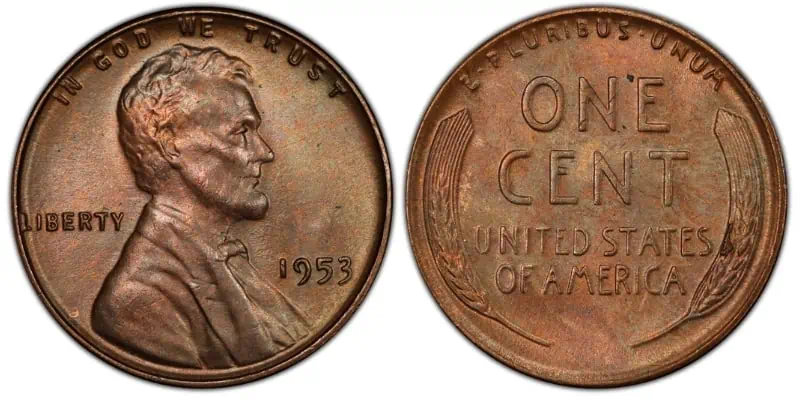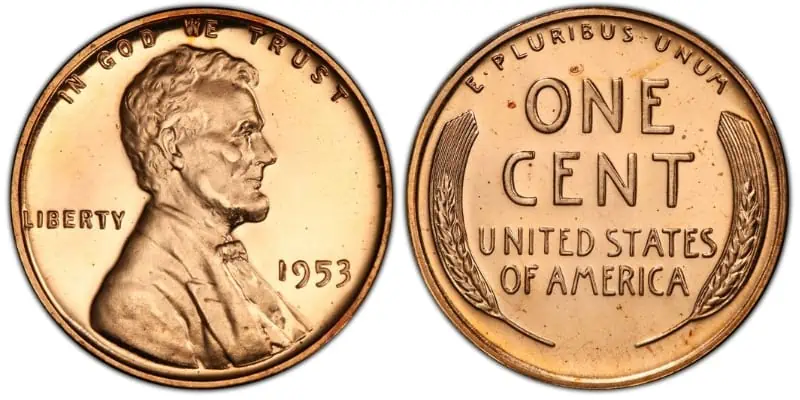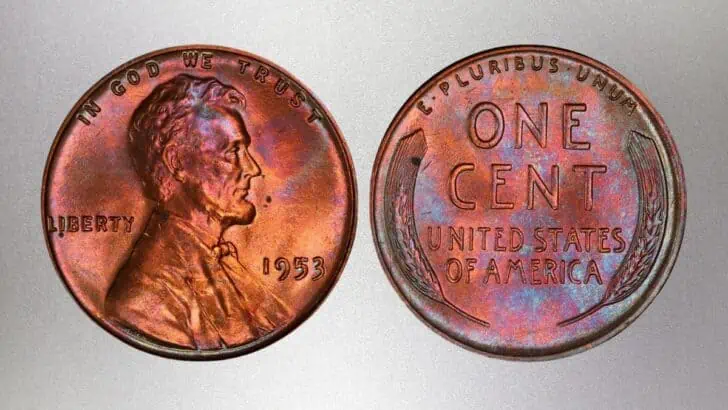The 1950s are a long time past, with customs and pleasantries almost too hard to fathom. A loaf of bread was 15 cents, a phone call was a nickel, and you could buy a stick of gum with a Topps baseball card for a penny. One cent!
But what if your grandma saved a 1953 penny and tossed it into a drawer? It might be quite valuable today, especially if it was a newly stuck coin with minor wear or some strange error that the mint missed!
When I was a kid, my mother gave me a bag of coins she had saved since she was little. It included pre-1909 Indian head pennies that she said you could get in change occasionally in the 1960s and ‘70s, lots of buffalo nickels, dimes, and quarters that were made with silver, and more Lincoln pennies with wheat stalks on the back than I could even count. It was an excellent start for my growing collection.
There were also mint coins in little 2×2-inch holders. Many of those coins were 1950s pennies; some were a dark chestnut color. I was excited!
The 1953 penny value has a fine history of increase and collectability; indeed, coins with a chestnut or red hue lead the way. A variety of coin conditions and errors are available and explained below!
Notes About US Pennies
The United States Mint produced the first federal coin for mass circulation in 1793 with “Lady Liberty” on the front. It’s enormous, about the size of today’s half-dollar, and is called a large cent. Various coin designs were used until 1857, when the modern smaller size was introduced (1856/57), starting with the Flying Eagle penny.
From 1859 until 1909, the US 1-cent coin was the Indian Head penny, made from bronze starting in 1864. In its last year, it shared production at the country’s mints with the new Lincoln head penny.
During the summer of 1909, Abraham Lincoln’s birth was celebrated with the introduction of a new US 1-cent coin, the Lincoln penny. Victor David Brenner designed the new penny, and his initials were briefly struck on the 1909 coins, the most valuable of which is an “S” mint VDB coin in MS Red condition that sold for $180,000.
The obverse of the penny shows President Lincoln in profile. Above his head are the words “IN GOD WE TRUST.” Although a two-cent coin was minted in 1864 with those words, the Lincoln penny is the first 1-cent coin with the motto. It was added due to US residents expressing a fear that we had Godless coins, to which Congress mandated on May 18, 1908, that US coins must have the motto.
The Lincoln penny was the first US coin to feature an actual person, and the composition of the coin also changed from the early bronze (88 percent copper) of the original Indian head penny.
In 1959, Lincoln’s 150th birthday, the penny got a facelift – for the reverse – as the old trusty wheat stalks were replaced with the Lincoln Memorial. On excellent condition coins, you can see the statue of Lincoln sitting in the middle of the memorial. Yup, Lincoln on the obverse, Lincoln on the reverse.
That changed in 2009 as Lincoln’s birthday merited another change to the penny, with Lincoln Bicentennial cents. Reverse coin styles featured a log cabin, Lincoln reading, Lincoln as a young lawyer, and the half-completed Capitol dome.
The following year, a union shield was introduced and is still used today.
1953 Lincoln Penny Specifics and Fine Points
Today’s Lincoln penny has changed its composition to 97.5% zinc and 2.5 % copper. The 1953 Lincoln pennies specifics follow.
Metal Composition: 95 % copper, 5% tin and zinc
Edge: Smooth – Plain
Coin Weight: 3.11 grams
Diameter: 19 mm
Thickness: 1.52 mm
Obverse designer: Victor D. Brenner
Reverse designer: Victor D. Brenner
US Mint Facilities: Philadelphia, Denver, and San Francisco
Although at times (such as in 1931), the US Mint in San Francisco struck less than a million coins, making them much more collectible and harder to find, 1953 was not one of those years. The total Mintage for US pennies in 1953 was 1,139,105,000. Individually, the mints were responsible for 700,515,000 in Denver, 256,755,000 in Philadelphia, and 181,835,000 in San Francisco.
Although a billion coins were minted, most coins show moderate to extensive wear. In addition, as bulk copper prices have risen, coins have been removed from circulation and sold as scrap.
As for specific mint marks, the reduced numbers struck in San Francisco command a bit of a premium compared to D and P, especially in Mint State coins.
1953 Penny Value

The 1953 Penny Value has slowly risen over the years, and individual coins are worth two to five of their face value in good to fine condition. Higher-graded coins command a premium.
| 1953 Penny Value Chart | ||||
| Type | Grade | |||
| Good G4 to About Uncirculated AU50 | Uncirculated MS63 | Uncirculated MS65 | Uncirculated MS67 | |
| 1953 1C BN | $0.20 to $0.33 | $0.80 | $3.38 | $47.25 |
| 1953 1C RB | — | $0.90 | $4.05 | $61.00 |
| 1953 1C RD | — | $2.60 | $24.30 | $2,620 |
| 1953-D 1C BN | $0.18 to $0.21 | $0.40 | $2.15 | $47.25 |
| 1953-D 1C RB | — | $0.55 | $4.05 | $61.00 |
| 1953-D 1C RD | — | $2.65 | $13.50 | $468.00 |
| 1953-S 1C BN | $0.2 to $0.33 | $0.80 | $3.38 | $49.95 |
| 1953-S 1C RB | — | $0.90 | $4.05 | $63.00 |
| 1953-S 1C RD | — | $1.35 | $10.80 | $162.00 |
Coin prices depend on scarcity and conditions. Plus, 1953 Penny Values have some added dimensions. By the 1950s, collectors were conditioned to hoard pennies marked “S,” so sometimes more coins were found in mint state.
In addition, the strike is generally weak on the 1953 Philadelphia Mint pennies, leading to a minimal number of superior MS66 and MS67 coins and higher prices for those same coins.
Proof coins struck in Philadelphia total 128,800. Each five coin set includes a Lincoln penny. While the average value of a set is $247, the 1953 Penny Value depends on the proof condition.

| 1953 Proof Penny Value Chart | |||
| Type | Grade | ||
| PR66 | PR67 | PR68 | |
| 1953 1C RD | $57.00 | $89.00 | $208.00 |
| 1953 1C CAM | $182.00 | $358.00 | $1,750.00 |
| 1953 1C DCAM | $960.00 | $3,750 | $10,000.00 |
Grading and Pricing Models for 1953 Penny Values
Grading and 1953 Lincoln penny values can be a bit confusing. Prices in the chart above indicate what you can expect on the open market, such as a coin shop. Dealers set their prices based on coin demand and condition, as well as what their cost was to obtain. Your cost will vary depending on the location, too.
Buying coins in person at a shop or coin show is usually a great experience. A coin show may have slightly higher prices because the vendors have significant travel expenses. Buying them online can have complications based on condition and quoted grades, so be careful.
The final line in the chart above with “Certified” may need clarification. Several companies professionally grade coins, including PCGS and NGC, and the Certified Acceptance Corporation, or CAC, certifies coins graded by a premiere coin-grading organization. It’s like a double grading, and collectors are more likely to purchase high-priced coins that are guaranteed.
Auction prices are higher because buyers seek higher-quality coins, and the competition can get heated. Sometimes, a coin goes for a much greater price than anticipated due to the competition or some heritage or provenance. A prior famous owner may sway interest in a coin.
Nearly ten years ago, at the 2014 January 8 – 12 FUN US Coin Signature Auction in Orlando, Florida, lot number 3565 set an auction record for 1953 pennies. While the PCGS price guide listed the coin at $3750, the 1953 1C MS67 Red PCGS Heritage Auction beauty cost an astounding $14,100.
The 1953 Lincoln penny is a great way to learn about conditions for your grading. Although many collectors want coins in any condition to fill a set, higher-grade coins have appreciated more over the years than lower-condition coins from the ‘50s.
Lincoln Penny Colors
With similarly struck coins in mind, let’s explain color. 1953 Lincoln pennies are mostly copper, which fades from a bright red hue to red-brown and finally brown over the years – even in storage. It’s not always the case and it seems unfair, but it’s a reality.
In the 1980s, a homeowner in San Francisco was doing a rebuild and found several old bottles and cans between the home’s wallboards. He also found coins: two 1909 pennies, a nickel, and a dime. One of the pennies was a bright red, the other a faded brown. The brown coin was an “S” VDB—a significant find in an uncirculated or mint state.
Still, if the red coin had been the “S” VDB, it could have been worth thousands more. Coin collecting, while thrilling and engaging, can be exasperating!
Between the bright reddish color often noted on prime coins, there’s an original luster color that many collectors apply to AU or almost uncirculated pennies. Because the 1953 penny is still readily available in this condition for a low cost, you may wish to stick with coins well above good, fine, and very fine conditions that show plenty of wear.
On the obverse of the coin, the lettering should be bold and distinct, while Lincoln’s hair should appear as actual locks, not just a few blobs of worn lumps. The jawline and beard should be significant and edged, not just a smooth rim from ear to chin. An AU or mint state coin also presents some mint luster or frost, and Lincoln’s ear should show several folds.
To get a better view, use a magnifying glass or jeweler’s loop for the best results. If your lighting is poor, take a photo with your phone and blow up the image. Smooth portions found on a coin are wear points. The more wear, the lower the grade. Although almost uncirculated means the coin looks new with few bag marks and little to no wear, a mint state coin MS60 and higher can be very difficult to differentiate. Because of this, when coins are of high value, involving a grading service is usually a good idea.
When you are purchasing a coin, especially at an auction, you’ll want to see perfect photos of the coin, and again, professionally graded coins will reduce the chance there are unseen issues such as rim defects or even warping of the coin.
Although it may be tempting, you should avoid cleaning your Lincoln pennies in any way. Coin dealers and collectors prefer their coins in a natural state. In the past, coins have been polished, cleaned with brass cleaner, and otherwise degraded by the desire to improve them. Examples are sometimes called whizzed coins and would rarely fool even a casual collector and certainly not an experienced dealer. Don’t do it!
1953 Penny Values in Error Coins
Years back, most collectors saw no value in error coins. They were considered an interesting but non-specific part of the hobby, and specimens beyond the 1955 Double Die weren’t overtly collectible. However, the market has changed because the mint strikes billions of coins with only a tiny fraction of a percent resulting in true errors.
| 1953 Penny Value Errors Chart | ||
| Coin Error Type | Circulated | Uncirculated |
| 1953-D 1C Repunched Mint Mark | $3.00 to $20.00 | $28.00 to $455.00 |
| 1953 1C Die Break | $5.00 to $10.00 | $15.00 to $29.00 |
| 1953 1C Double Die Obverse | $3.00 to $15.00 | $129.00 to $154.00 |
| 1953 1C 50% Off Center Strike | $10.00 to $20.00 | $25.00 to $30.00 |
| 1953 1C Clipped Planchets | $2.00 to $10.00 | $10.00 to $75.00 |
Conclusions on 1953 Penny Value
All three US Mints produced large numbers of 1953 Lincoln pennies, and you can still find excellent condition coins in circulation. However, wheat pennies are older and considered more collectible than memorial coins, so they are found in lower and lower percentages in daily change.
Coins in good to fine condition are likely worth only a nickel, but they can command 100x that value if they contain significant errors. Because of the large production runs by the US Mint, coins in AU and MS are relatively inexpensive. As the condition moves towards MS62+, they become much more valuable.
Remember that well-stuck 1953 pennies from the Philadelphia Mint in MS condition also demand a premium as they are harder to find.
